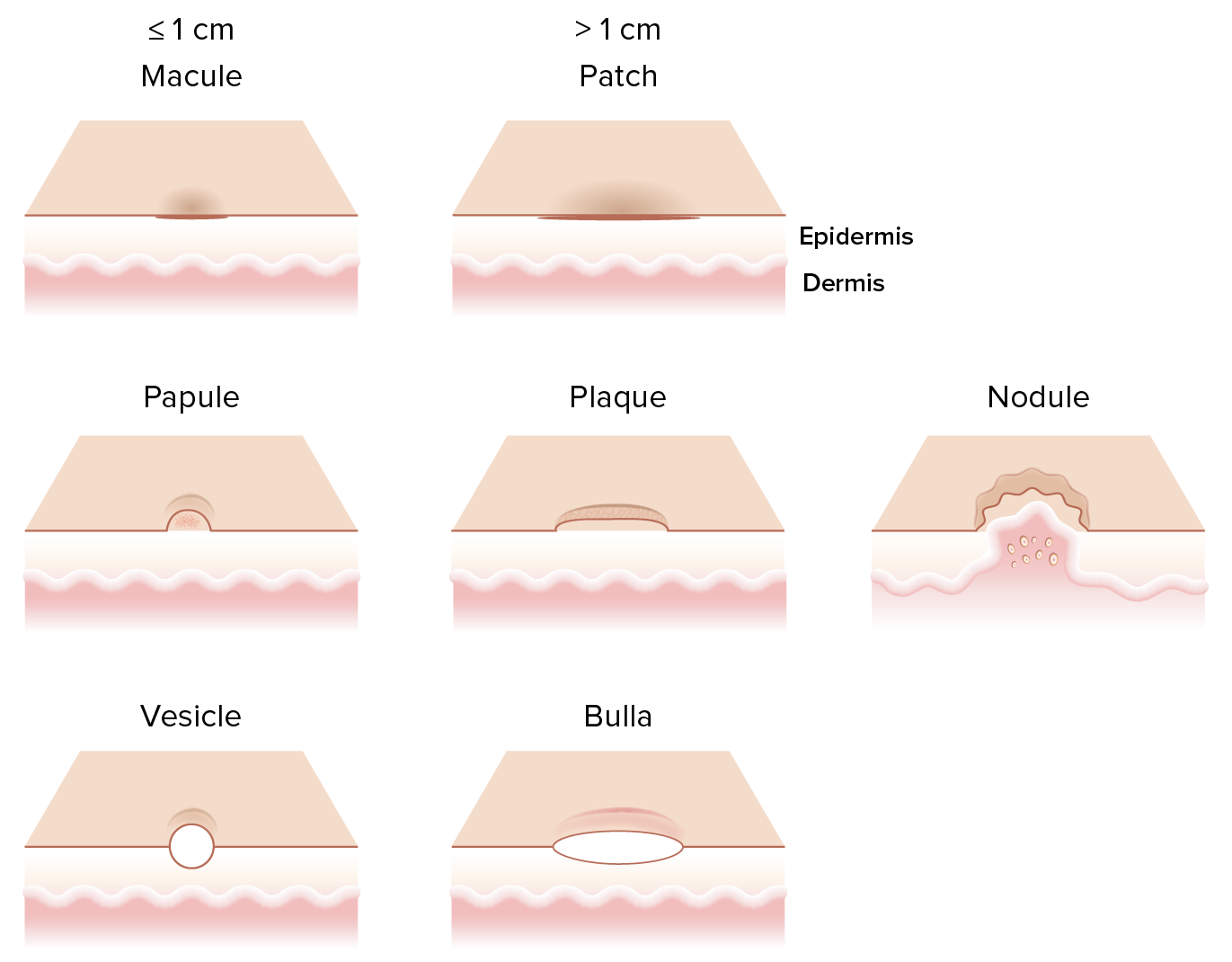Playlist
Show Playlist
Hide Playlist
Primary Skin Lesions
-
Slides Primary Skin Lesions.pdf
-
Download Lecture Overview
00:01 Welcome to our lecture on introduction to. 00:04 Classification of skin lesions. 00:06 It's important that we are able to communicate and classify the skin lesions so that when you are discussing or consulting or describing to someone, you are able to speak the same language. 00:20 So how do we classify skin lesions? We classify them into primary, secondary and lesion configurations focusing on primary lesions. There is a module. 00:34 What do we mean by Michael. 00:36 It is a flat non-palpable lesion which is less than one centimeter in diameter. 00:41 It is not raised or depressed compared to the skin surface. 00:47 It could be hypo or hypopigmented. 00:50 It can be pink, red or violet depending on the skin condition that one is dealing with. 00:58 The second type is a patch. 01:00 How do we define a patch? A patch is a large module more than one centimeter. 01:06 Remember the module is less than one centimeter, so the patch will be more than one centimeter. 01:13 So what are some of the examples of modules and patches? For example, look at this picture. 01:20 This is a patient with vitiligo with hypopigmented macules and patches. 01:26 So the lesions some of them are less than a centimeter and the others are more than one centimeter. Melasma, which is a very common condition amongst Africans, is also a typical example of a hypopigmented, a mature and sometimes patches. 01:46 A patches can also be red, white or depigmented, so this is a maculopapular rash which is erythematous or red. 01:59 What is a papule? A papule is an elevation due to an increased thickness of the epidermis, and it could be due to cells or deposits within the the dermis. 02:11 So the operating word is that it must be Elevated. 02:16 It is less than one centimeter in size and it can be palpated or felt with the finger. 02:23 These are some examples of papules. 02:26 For example, the picture on the left. 02:28 This is a patient with molluscum contagiosum with a number of umbilicated papules on the right it's a patient again with lots of verrucous papules due to common warts. 02:42 So again it is raised. 02:44 It can be palpated and it's less than a centimeter. 02:49 What about plain warts. 02:50 These are flat papules so you cannot actually feel them. 02:54 So this is another example of a papule which is flat and moving on to a plaque. 03:02 It's an elevation which can be due to increased thickness of the epidermis and or cells or deposits within the dermis. 03:09 It is more than one centimeter in diameter and it is circumscribed. 03:14 It can be felt and palpated. 03:17 What are some examples of plaques? For example, psoriasis, a very common condition commonly consists of epidermal plaques. Another condition is. 03:28 An example of a plaque is Latin simplex chronicus. 03:31 This is a type of eczema that we see in patients who tend to chronically scratch their skin. Sarcoidosis is another example of a primarily dermal plaque. 03:45 Moving on to a nodule. 03:47 How do we describe a nodule? It's an elevated, circumscribed lesion that is larger than a papule and is often more than 1.5cm in diameter. 03:58 It is usually located in the dermis or in the subcutaneous layer. 04:03 It can be compressible, soft, rubbery, or firm to palpation. 04:08 So what are some of the examples of a nodule? A lipoma, for example, which is a collection of fat. 04:14 You can see it is raised on the surface of the hand. 04:18 Fibromas, which are typically seen in a condition called neurofibromatosis, which is a genetic disorder. 04:25 It contains I mean, it consists of all these lesions. 04:30 Another interesting condition is erythema nodosum, as you can see. 04:34 Erythema means red nodosum nodule and it is also palpable and it is erythematous. 04:41 How do we define a vesicle? It's an elevated, circumscribed lesion which is less than a centimeter in diameter, and it is filled with clear fluid. 04:52 Some examples of vesicles are patients with herpes labialis fever blisters. 04:58 That's what we call it. Fever blisters. 05:00 This is a typical example of a visceral and of course varicella zoster or chicken pox is also a condition that typically presents with vesicles. 05:11 Patients with acute allergic contact dermatitis can also present with vesicles as a result of their reaction to an allergen. 05:20 A bully. It is elevated, circumscribed more than a centimeter in diameter, and it is filled with clear fluid. 05:28 Some examples are, for example, a vesicle bullous tinea pedis. 05:33 You can see these are big bully on the feet Drug reactions are also examples of lesions where patients can present with bullae. 05:43 This is a typical example of a bully. 05:47 Autoimmune diseases and this particular one is called pemphigus vulgaris. 05:54 Moving on to the definition of a pustule, it is an elevated, circumscribed lesion, typically less than one centimeter in diameter, and it is filled with pus or purulent material. 06:05 This can be infectious or sterile. 06:09 What are some of the examples of partial? This is a patient with lots of folliculitis and pustules on the face. 06:19 Acne vulgaris. 06:20 Also, as you know, a patient with acne may have papules or papules or blackheads. 06:24 So in this case actually the pustules are sterile. 06:30 The will is a transient elevation of the skin due to dermal edema. 06:35 And an example is the patient with urticaria. 06:39 This is a will. It's red and it's edematous.
About the Lecture
The lecture Primary Skin Lesions by Ncoza Dlova is from the course Introduction to Dermatology.
Included Quiz Questions
Which of the following defines a macule?
- Flat, nonpalpable lesion, under 1 cm in diameter
- Raised, fluid-filled lesion, over 1 cm in diameter
- Raised, palpable lesion, under 1 cm in diameter
- Flat, scaly lesion, over 1 cm in diameter
- Depressed, nonpalpable lesion, over 1 cm in diameter
Which of the following defines a plaque?
- Elevated, circumscribed lesion, more than 1 cm in diameter
- Flat, nonpalpable lesion, under 1 cm in diameter
- Depressed, fluid-filled lesion, more than 1 cm in diameter
- Raised, circumscribed lesion, less than 1 cm in diameter
- Flat, scaly lesion, under 0.5 cm in diameter
Which of the following defines a pustule?
- Elevated, circumscribed, pus-filled lesion, typically less than 1 cm in diameter.
- Flat, nonpalpable lesion, more than 1 cm in diameter.
- Raised, fluid-filled lesion, over 1 cm in diameter.
- Depressed, fluid-filled lesion, typically less than 1 cm in diameter.
- Elevated, scaly lesion, more than 1 cm in diameter.
Customer reviews
5,0 of 5 stars
| 5 Stars |
|
5 |
| 4 Stars |
|
0 |
| 3 Stars |
|
0 |
| 2 Stars |
|
0 |
| 1 Star |
|
0 |




